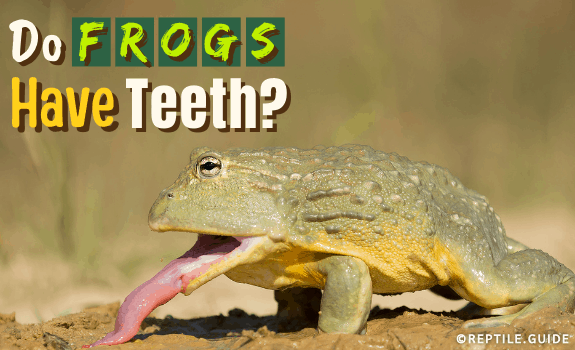Many frogs have tiny teeth built into their upper jaws, and few frogs and toads have teeth in the lower jaw.
Despite the fact that most tadpoles have teeth, adult frogs of only one species, Gastrotheca guentheri, have true teeth.
“Do frogs have teeth?” Let’s delve into the world of vomerine teeth, true teeth, and maxillary teeth. You’ll also learn about how the evolutionary history of frogs means that they’ve lost teeth over 15 times!
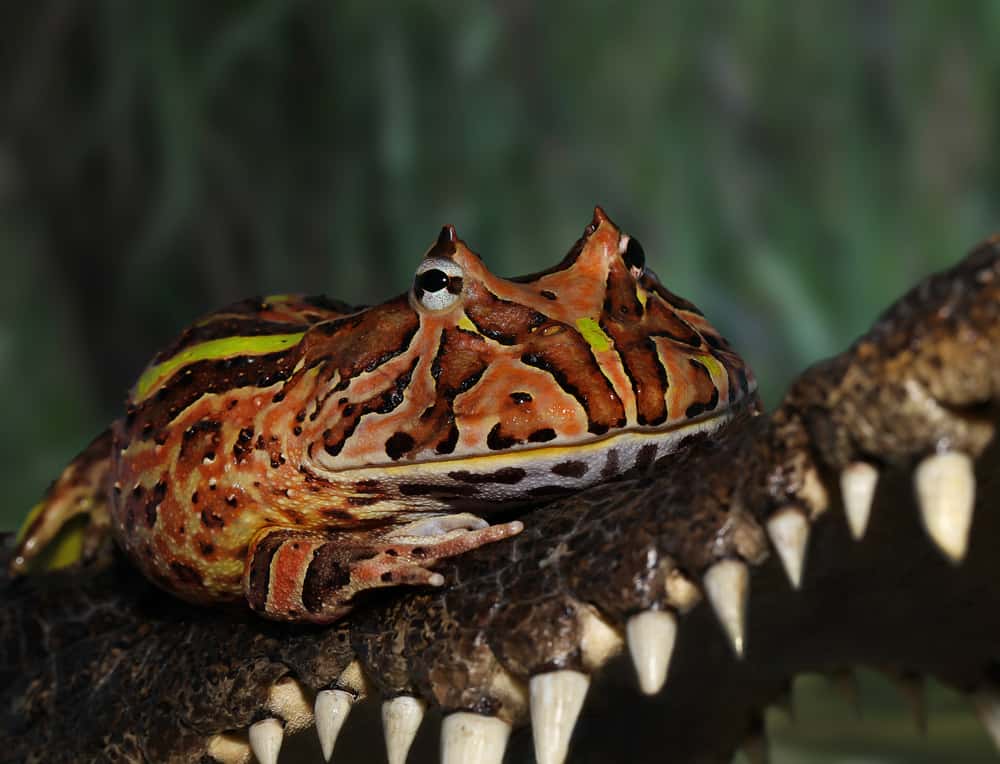
Let’s get into it.
In This Article
In Short
- Many frogs have tiny teeth built into their upper jaws, and few frogs and toads have teeth in the lower jaw.
- Some species of frogs can bite with up to 6.6 pounds of force.
- Scientists use tadpoles’ teeth, or oral plates, to identify different species.
- Frogs have lost their teeth over the last 100 million years of their evolution.
Do Frogs Have Teeth in Top Jaws?
Do frogs have teeth in their top jaws? Frogs have bone projections which resemble teeth in their upper jaw.
When frogs have teeth at all, they generally only have teeth on the upper jaw.
You can find two types of frogs’ teeth in the upper jaw.
The first type is the maxillary teeth. You can find these tiny teeth around the outer perimeter of the upper jaw.
The second type is the vomerine teeth, which are on the roof of the frog’s mouth.
Neither type of tooth is an actual independent tooth, like those found in mammals or crocodiles.
According to scientists, frogs evolved an absence of teeth in the lower jaw around 230 million years ago.
This lack is unusual when you consider amphibians like salamanders that have a full complement of teeth.
One frog species, Gastrotheca guentheri, evolved again to feature the lost teeth in the lower jaw. They assume that it evolved again, less than 20 million years ago.
Gastrotheca guentheri is one of the remarkable marsupial frog species from Central and South America.
In Gastrotheca guentheri, the teeth aren’t outcroppings of bone or maxillary teeth—these frog teeth are the real thing. The tiny teeth in this frog’s mouth are only about 1mm in size.
The Florida Museum has done a comprehensive analysis; if you’d like to learn more about the toothless frog, Gastrotheca guentheri, and other evolutionary wonders in the world of amphibian mouths.
How Do Tadpoles Eat?
Before you can truly understand a frog’s teeth, it’s necessary to understand how frogs eat.
Not all the information we share here will apply to all 5,000 species of frogs, but it will help you understand the basics.
Let’s start at the beginning, with baby frogs.
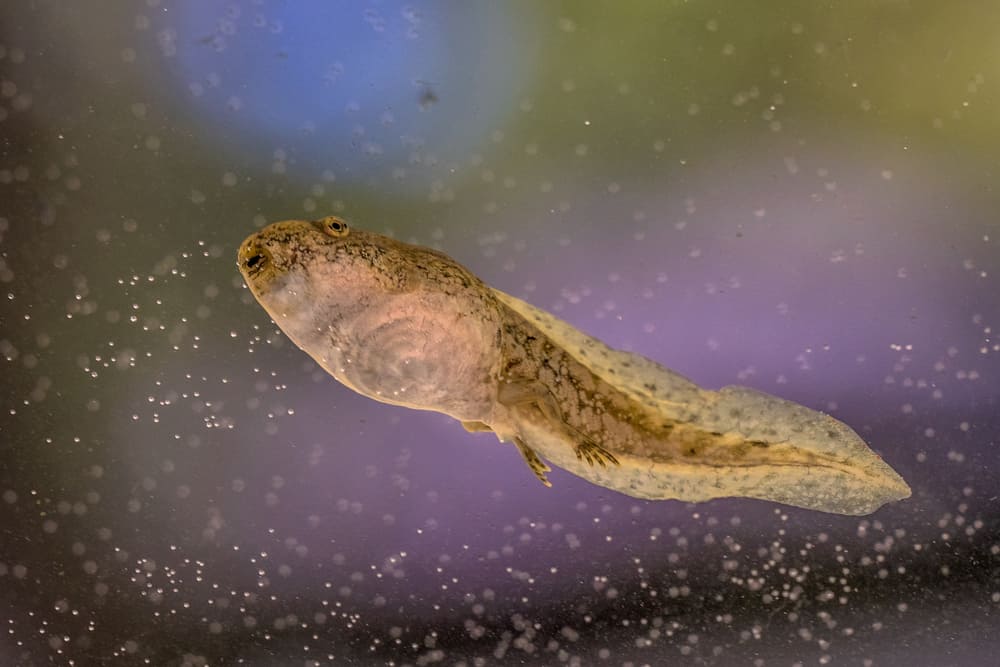
There are three main types of feeding in tadpoles:
- Grazing (have teeth) – This is the category to which most tadpoles belong. These free-swimming tadpoles swim around and ‘graze’ algae and microorganisms from rocks, branches, and even leaves.
- These tadpoles always have teeth, and scientists use those teeth (or oral discs) to help identify different species. This type of tadpole usually has anything from one to eight rows of teeth, depending on the frog’s species.
- Examples of this kind of tadpole include the Wood Frog and North American Water Frog.
- Filter Feeding (rarely have teeth) – Tadpoles that filter feed rarely have teeth (because they don’t need them) and survive by filtering the water for algae, microorganisms, and other food sources.
- Examples of filter-feeding tadpoles include the African Clawed Toad and Rubber Frogs.
- Direct Development (no teeth) – This is an unusual type of development that isn’t common among frog species. Instead of a tadpole phase, these frogs have large, moisture-filled eggs, in which the egg develops directly to a small frog. These animals lack teeth in the developmental stage.
- Examples include the African Rain Frogs and Puerto Rican tree frogs.
Fun Fact: African Dwarf Frogs offer one exciting exception to the tadpole eating regime. These tadpoles eat other living creatures but don’t have any teeth.
How Do Frogs Eat?
After the tadpole phase, frogs enter metamorphosis. During this process, the frog’s skin changes, and it undergoes an almost complete reconstruction of its face and jaw.
As a result, frogs go without food during this time and are entirely toothless. Instead, the tadpole’s body uses the energy from absorbing its tail to help power essential changes.
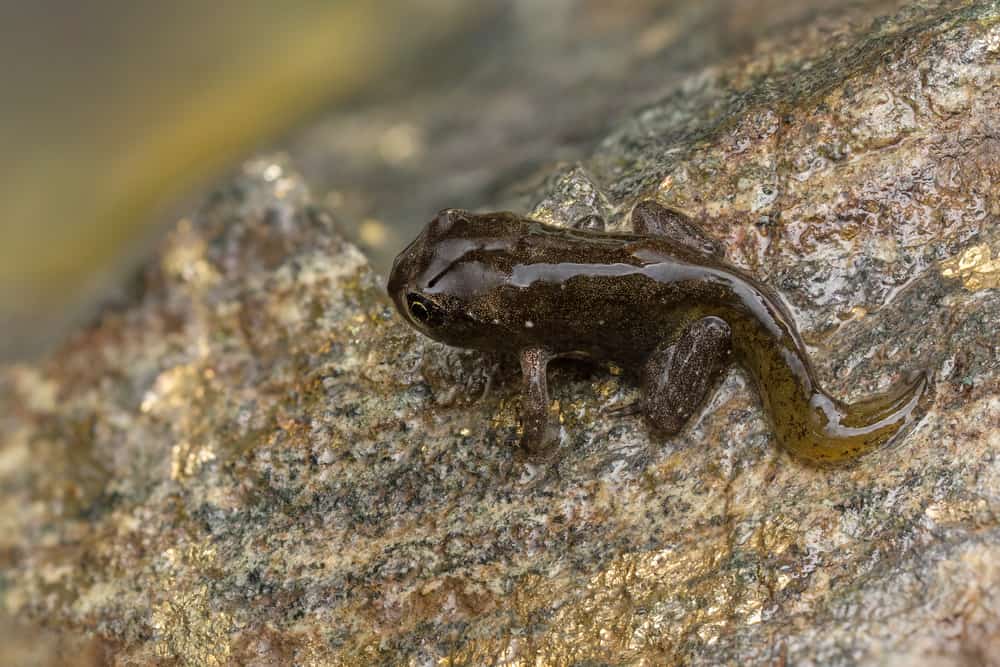
Adult frogs have a vastly different diet than tadpoles and require teeth (or something like them) for catching prey.
Like most amphibians, all adult frogs are predators, but they lack the muscles needed for chewing, so how do they process their food?
A frog can’t swallow using its tongue.
The tongue is fixed to the front of a frog’s mouth. A frog uses its tongue to flick small prey items into its mouth.
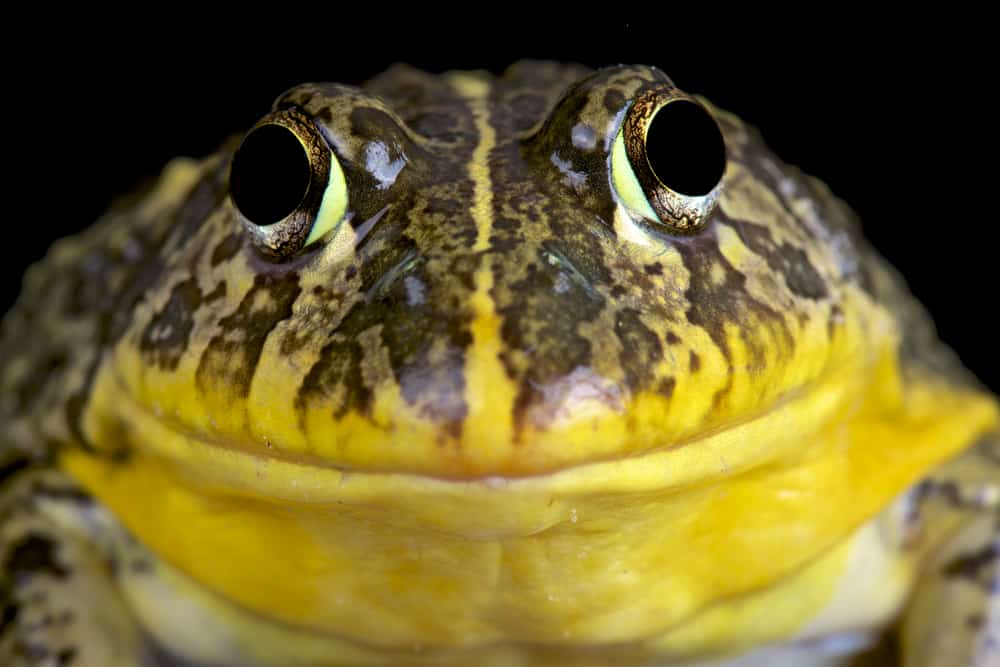
Since frogs are incapable of chewing (in the conventional sense) and can’t swallow with their tongues, how do they eat?
A frog will grab prey, gripping it between the upper and lower jaw. Despite the bony outer ridge, the roof of the frog’s mouth is soft.
By pushing down their abnormally large eyeballs, the frog places pressure on the soft upper jaw and forces the prey down its throat.
This adaptation is why frogs always blink when they eat.
When it looks like a frog is chewing, it’s moving the prey item to a place where its ‘teeth’ can grip it, and the frog can swallow it.
We have a whole article about what frogs eat if you’d like to learn more.
Except for some aggressive species, like the African Bullfrog, most frogs are more likely to run away than bite humans.
Do Toads Have Teeth?
We know that frogs have teeth (of a sort) but do toads have teeth?
A toad doesn’t belong to any specific taxonomical group, but teeth are unusual among them. People refer to many types of frogs as a toad.
The species that scientists refer to as ‘true toads’ belong to the family Bufonidae and are entirely toothless.
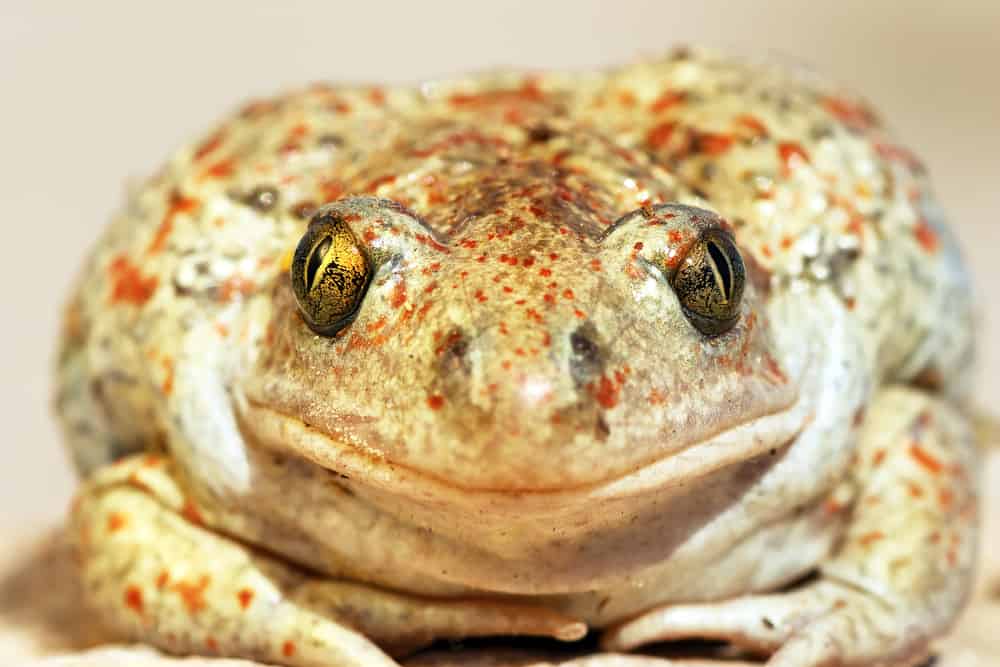
In some cases, the toad may have maxillary teeth in the upper jaw, but it rarely has structures like the vomerine teeth in the roof of its mouth.
Check out our article about the differences between frogs and toads for more information.
Do Pacman Frogs Have Teeth?
Pacman frogs are some of the most popular species of pet frogs on the planet. New keepers often ask the question, “Do Pacman frogs have teeth?“
Because Pacman Frogs are carnivorous and need to grip their prey, they require a sturdy set of teeth.
Like most other frogs, these animals have vomerine teeth—In Pacman Frogs, these bony protrusions are exceptionally well developed.
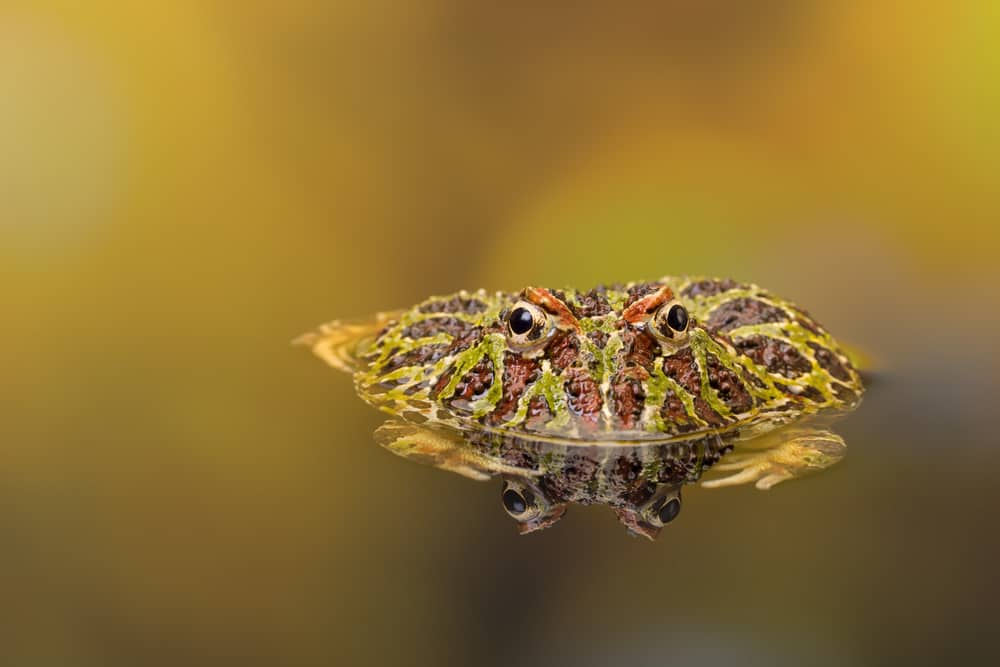
Pacman Frogs also have a complete set of maxillary teeth and can draw blood when they bite. Most keepers consider the teeth of these frogs to be some of the most effective among frogs.
Fun Fact: Even without standard teeth, frogs can bite with nearly seven pounds of force—a helpful attribute when catching prey.
You can read more about Pacman Frogs in our comprehensive care sheet.
Do Bullfrogs Have Teeth?
Perhaps one of the most exciting questions relating to frog teeth is, “Do bullfrogs have teeth?“
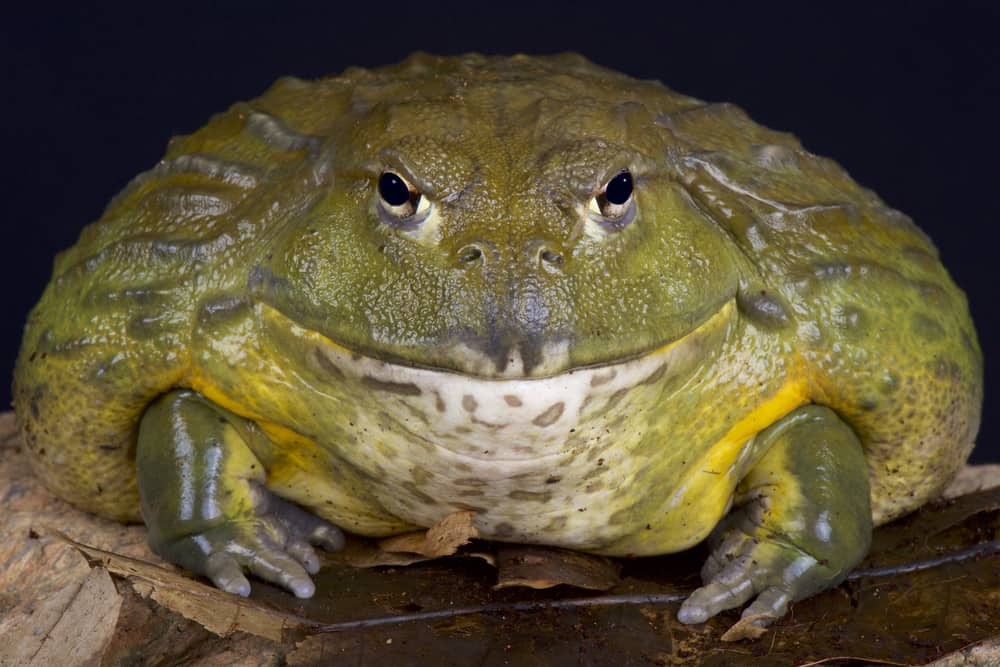
While most frogs only have vomerine teeth on their upper jaw, African Bullfrogs have sharp, fang-like projections on their lower jaw.
They also have a set of vomerine teeth on the roof of their mouths, so they’re capable of delivering a painful bite.
People have observed these frogs eating birds, rats, and even snakes in the wild. The younger animals will happily eat things that are easier to swallow, like ants.
African Bullfrogs, or Pixie Frogs, make fascinating pets. You can read more about them here.
We hope you’ve enjoyed this article about frog teeth. While most frogs only have teeth on their upper jaw, you’d be wise to treat them with respect.
If you’re thinking about getting your first pet frog or adding one to your collection, remember to check out our guide to the best pet frogs.
If you have any thoughts, ideas, or questions, feel free to leave a comment below. We’d love to hear from you.
